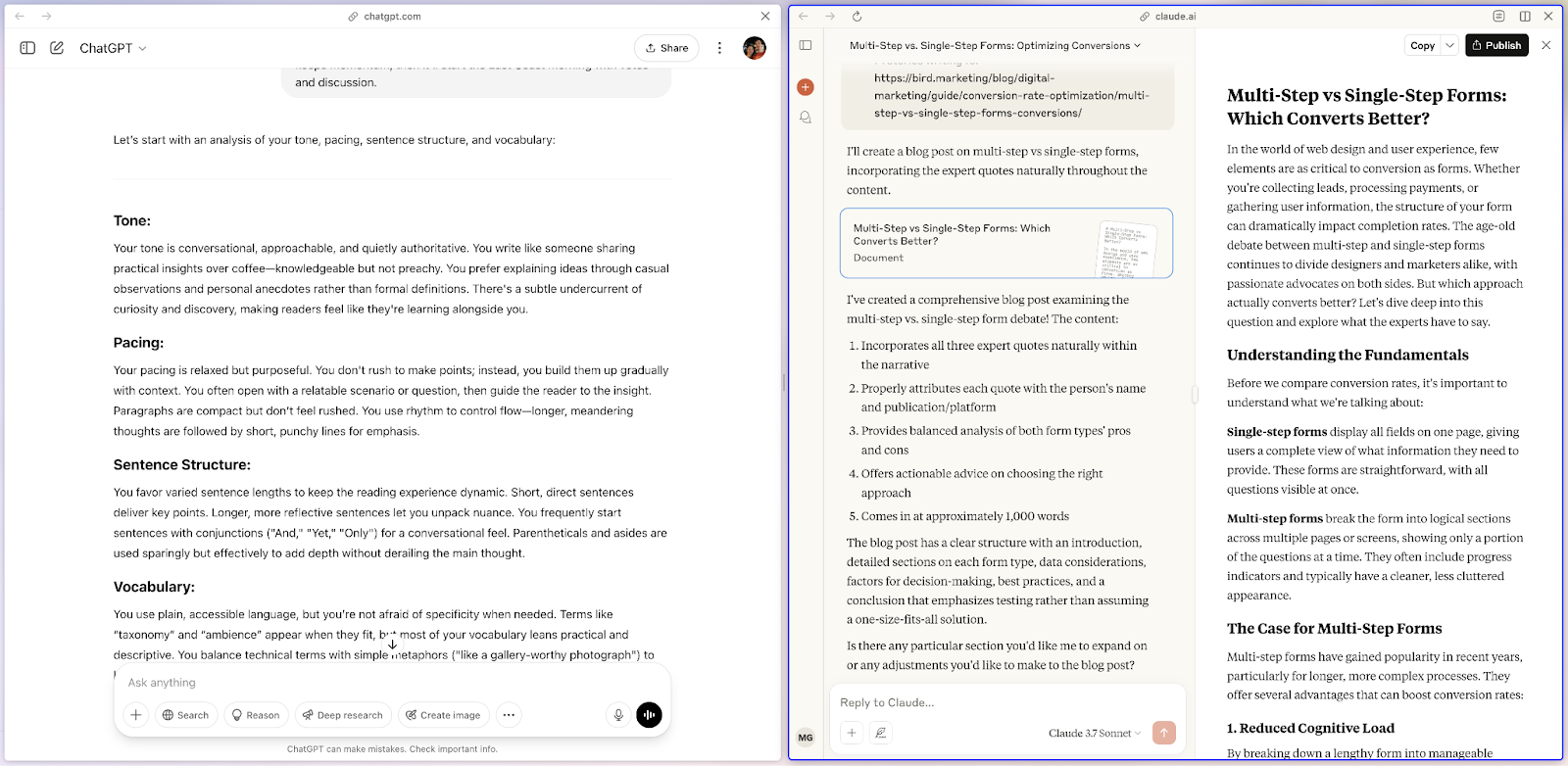Top AI writing apps
- Lex: Best for focused writing with an AI sidekick
- Frase: Best for writing SEO-optimized text
- Writesonic: Best for longform writing
- Notion AI: Best for summarizing notes and databases into quick writing
- Microsoft Word Copilot: Best for writing traditional documents
In 28 seconds, ChatGPT can research and write a 693-word article about recent advances in artificial intelligence (AI). In even less time, it can organize your notes into an outline or highlight areas for improvement in your first draft. That makes AI an indispensable writing assistant today. It’s a massive leap forward, even if we’ve been steadily moving towards it for decades.
It started with an epiphany in 1961 — a decade before the first email and 30 years before the first web page. “It became evident that poor spellers needed help,” wrote developer Les Earnest. So he repurposed the 10,000-word database he’d built to teach computers to recognize handwriting and created the first spellcheck.
You’d write, and the computer would highlight words not in the database as misspellings — the same way spellcheck works today. That grew into autocorrect (guessing the word you meant to type) and predictive text (suggesting “eat” after you type “what would you like to”). One innovation at a time, and suddenly computers could write for you.
When ChatGPT launched in late 2022, it’d been trained on billions of words and over 175 billion parameters (the connections between words and phrases). What we call AI tools today are more accurately large language models. They’re text generator AIs, guessing which word should come next based on their database — only now with databases that include most written human knowledge. And they can learn from you, melding your ideas and writing style with their database to write something that approximates your voice and tone. Prediction, it turns out, can write impressively well.
I tested 28 of today’s most popular AI writing platforms, cutting the shortlist down to the ones that are most effective at finishing your thoughts, expanding on your ideas, and writing long-form content that incorporates your research, quotes, links, and keywords. From students and occasional writers to full-time marketers and content creators, the best AI writing tools should be a helpful addition to every writer’s workflow — and here are five that fit the bill.
What makes a great AI writing app?
Great AI writing apps start with the basics: A rich text editor, keyboard shortcuts to add formatting, spelling and grammar tools to catch typos, and export options to save a Word or PDF file or publish your writing online. They then add AI into every step of the writing process, with tools to research a topic, organize details into a logical outline, write the first draft, finish a sentence or paragraph when you get stuck, and then help you iterate until you’re ready to publish. All the while, they should leave the writing power in your hands — giving you full control over the finished piece.
Any AI tool today can write a few paragraphs about a topic. The best AI writing apps go beyond that. They let you add your research, writing articles about specific keywords that include links to your other content. They should learn from earlier pieces to write in your voice or your brand’s style. And they should carefully include quotes, links, and research without hallucination for authoritative writing that your readers can trust.
How I tested and chose the best AI writing apps
I started by researching the most popular AI writing platforms, from AI features in more traditional software like Microsoft Word and Google Docs to newer AI-focused software like Lex and chat-focused platforms like ChatGPT and Claude. I landed on over 28 tools and looked through their core features and pricing to see which seemed most promising. From there, I signed up for the 15 AI writing apps that caught my eye the most, testing them across a variety of common writing scenarios.
To keep it fair, I had each app write the same sample articles, researching and writing a thousand words about a handful of topics. I then tested for recency and accuracy. I asked them to write in a certain style based on three writing samples, and had them complete a half-written article to see how well they could match the voice and tone. I requested they include keywords, links, quotes, and Markdown formatting to assess their flexibility, customizability, and lack of hallucinations. And I used their built-in editing tools to tweak the text and export finished drafts, ensuring they fit well into a writing workflow.
The best AI writing apps in 2025
| Name | Best for | Unique feature | Plans/pricing |
|---|---|---|---|
| Lex | Focused writing with an AI sidekick | Type +++ anytime to have AI finish your sentence or paragraph | $18 per month |
| Frase | Writing search engine optimization (SEO) content | Keep the focus on long-tail keywords with Frase’s SEO sidebar that details your article’s links, keywords, and comparative score | $3.50 per document or from $45 per month |
| Writesonic | Long-form writing | Choose your content length, and Writesonic can generate anywhere from 500 to 5,000 words | Paid plans start at $20 per month for five articles |
| Notion AI | Summarizing notes into quick writing | Chat about your notes, find recurring themes, and summarize writing quickly with Notion’s AI chat | $10 per month per user for unlimited Notion AI |
| Microsoft Word Copilot | Writing traditional documents | Use AI in the familiar Microsoft Word interface to quickly outline or write template documents | Paid plans start at $9.99 per month for Microsoft 365 Personal with Copilot |
1. Lex: Best for focused writing with an AI sidekick
Lex is built around three writer-focused tools. You can
- Start with a blank page, similar to Medium’s blog post editor, where you add a title and then start writing.
- Import an existing document, then use Lex AI tools to edit and improve it.
- Start with Lex’s AI chat to brainstorm your ideas, kick off research, build an outline, and start your first draft.
Either way, the same tools are at your disposal. There’s a chat sidebar where you can speak with AI about your document or use built-in prompts to get feedback, flag confusing parts or weak arguments, or jumpstart your writing and get over writer’s block — among dozens of other prompts.
You can create your own prompts to save default AI snippets to write in your voice and tone, summarize your article into a social media-length post, write a template article in your blog’s style, and more. You can also choose the AI model to use. Lex uses GPT-4.1 by default, and also includes Claude 3.7 Sonnet, Sonar by Perplexity, DeepSeek-R1, and Llama 3.2 among others.
Or you can use AI inside of your document. Unsure what to write next? Type +++, and Lex will complete your sentence or paragraph. Concerned about your writing’s readability? Open the Checks pane to find grammar mistakes, fix passive voice, identify hedging statements, remove repetition, and more. It’s AI that can both write for you and make you a better writer.
Lex offers perhaps the nicest writing experience of any app I tested. It lets you focus on writing, with dark and light themes, a focus mode that hides all the tools, and a selection of fonts to make the editor look the way you want. You can even start a Pomodoro timer to fix your attention on your writing and remind you when to take a break.
If you love writing but want an AI assistant to sit alongside you, this is an ideal AI writing app. Lex’s publication tools are built for content marketing: You can publish your writing in a Kit newsletter or copy it as Markdown or HTML-formatted text to publish on your blog.
- Pros: Quickly complete a sentence or paragraph by typing +++, choose which AI model to use, save AI prompts for common writing tasks
- Cons: Few research tools, less consistent at adding references to articles or in chat results
- Plans/pricing: Free trial with basic AI model access; paid plans start at $18 per month for premium AI models including GPT-4o and Claude 3.5 Sonnet, unlimited usage, and priority support
2. Frase: Best for writing search engine-optimized text
There are a lot of apps that look like Frase, with a document editor on one half of the screen and AI-driven SEO advice on the other. Many of them have a graphical meter to show you how search-engine optimized their AI perceives your article to be. For my money, Frase is the best of the bunch at this particular niche of AI writing.
You start by giving Frase a search query and the location where you want your article to rank well in search engines. After a few minutes, it spits out everything you’d need to create an optimized article. With that research in hand, you can click the “Generate brief” button to organize all the findings into something shareable and succinct, or hit the “Generate headings with AI” button to create an outline. You could also take another route entirely, clicking anywhere in the text editor and pressing the spacebar to open a chat interface where you can enter any writing prompt you want.
Outside of the editor, there are tools for domain audits and topic suggestions. My favorite, though, was the directory of AI prompts and templates from the community with dozens of user-generated tools to significantly speed up AI content creation.
Generally, Frase’s outputs were shorter than I asked for. There also seemed to be an inherent bias towards flat authoritative writing, which makes sense for SEO writing but lacks personality that improves readability. While you can address that with the “Create a brand voice” tool, it’s limited to 5,000 words of reference via textbox – no URL or file upload options like Writesonic.
Frase was decent at adding authoritative links into articles, but it occasionally hallucinated URLs, linking to 404s. It was much more consistent about adding in bulleted and numbered lists, correctly tiered subheadings, and bolded text in places where it made sense.
If you’re willing to pay $3.50 per article, Frase’s Rank-Ready AI Document feature delivers noticeably better outputs by asking some guided questions. But you can easily create SEO-friendly articles without paying extra, thanks to the detailed research features built into Frase’s editor.
- Pros: Detailed SEO-driven AI writing, authoritative suggested and included links, community AI prompts and templates
- Cons: Low word count outputs, brand voice prioritizes sliders over references
- Plans/pricing: Paid plans include the Basic plan for $45 per month (30 research documents and unlimited AI-written words per month) and Team plan for $115 per month (three users and unlimited research documents), as well as a pay-as-you-go option from $3.50 per document
3. Writesonic: Best for long-form writing
AI writing platforms live or die on their user interfaces. Writesonic’s actual writing interface is somewhat barebones, but its multiple ways to generate long-form content with intuitive tone and style customization make it an AI-first interface that smoothly guides you through the process.
While there’s significant emphasis on SEO (and generative engine optimization, or GEO) in Writesonic’s onboarding and dashboard tutorials, it doesn’t feel as overwhelming as some of the other apps I tested. There are plenty of tools and features for digging into the optimization details, but you can just as easily skip them and generate a long-form article written by AI without worrying much about SEO or GEO.
Your two main options are Chatsonic and AI Article Writer. Chatsonic, as the name suggests, is a chat interface similar to what you see in ChatGPT and Claude. The main difference is the ability to switch between your saved brand personas and AI agents that specialize in SEO, content marketing, or social media generations. Chatsonic was also Writesonic’s best tool for creating articles that incorporated the quotes and citations I had already sourced. I felt, however, that AI Article Writer was a much better experience overall.
Writesonic’s AI Article Writer guides you through 10 steps, essentially breaking the prompting process down into smaller chunks and using context from previous steps to recommend how you approach later steps. It helped me create detailed content briefs in relatively little time. Afterwards, it turned briefs into full-fledged articles, with outputs that sounded close to the three articles I provided for style reference. It also matched my requested word count more precisely than anything else I tested and linked to external articles that were less than two weeks old. And while most other AI writing apps came short of my requested 1,000 words per article, Writesonic let me request anywhere from 500 to 5,000 words — and actually delivered on that word count.
If you prefer a structured, guided process when creating an article brief — and then turning that brief into a long-form article — Writesonic is the AI to use.
- Pros: Excellent tone and style options, detailed 10-step prompt creation, can choose word count in 1,000-word increments
- Cons: Mediocre text editor, SEO tools aren’t super detailed
- Plans/pricing: Free trial; paid plans include $16 per month for five articles and one writing style, $39 per month for 15 articles and two writing styles, and $79 per month for 30 articles and five writing styles
4. Notion AI: Best for summarizing notes and databases into quick writing
Notion can be almost anything you want it to be. It’s a notes app — a place to save your thoughts or collaborate with your team around critical company knowledge. It’s an app builder — with a database that you can tweak into a tailored customer relationship management platform, a content management system, an inventory tracker, and more. And it’s a project management tool — where you can keep tabs on tasks and goals, and store the notes and data needed to complete them.
Add AI into the mix, and Notion is one of the best tools to write quick bits of text based on your notes and stored knowledge. You can use Notion AI to develop tools for your team, with built-in prompts to create a task management or feedback tracking system among other simple apps. You can then automatically fill out those databases with AI-generated summaries and insights, or have Notion use the details in the database to write summaries and data-driven articles — perfect for small business content marketing teams already using Notion. With a paid Notion AI plan, you can even chat with the AI to search through your notes, PDFs, and files from connected apps.
Notion’s default AI tends to write shorter text than some apps, with more of a focus on pulling insights and summaries together than on creating long-form content. It also includes older data by default, and is less likely to pull in external links on its own. That makes it an AI copywriting tool that’s best kept for summarizing your blog posts and documentation into other content formats for social media and newsletters. With Notion’s paid AI plans, though, you can choose your AI model — this lets you use Notion’s AI for internal search and to summarize your existing data, while also using GPT-4.1 and Claude 3.7 Sonnet for deeper research and longer form writing as needed.
- Pros: Build writing plans, create a database for your content, and write in the same place; use AI to write based on your existing notes and data; summarize writing or turn it into an action plan with a click
- Cons: Uses older, less up-to-date AI models on free and lower tier plans; tends to write shorter text
- Plans/pricing: Free version (basic AI); paid plans start from $10 per month for unlimited notes, and an AI add-on for advanced GPT-4 and Claude models as well as search across Slack and Google Drive is an additional $10 per month minimum
5. Microsoft Word Copilot: Best for writing traditional documents
Microsoft Word was one of the first word processors to bundle spell check with Word 6, then autocorrect with Office 4. Now, thanks to Microsoft’s partnership with OpenAI, AI has become a core feature too — so much so, that the Microsoft 365 app (previously known as Office) has rebranded as Microsoft 365 Copilot.
No more staring at a blank Word document wondering what to type. Today, there’s a “What do you want Copilot to draft?” prompt at the top of every new Word document, along with prompts for common document types like creating a resume outline or a schedule, and a Copilot chat sidebar on the right of your screen as a modern Clippy (that actually works).
Word’s AI is limited in a few ways. It uses an older AI model than most other apps I tested, referencing events from a year ago (where newer models often include events from as recently as a month ago). It also can’t add links, either from its own research or ones that you share directly, and will instead add placeholders for you to then insert yourself.
Where it does shine is in pure writing. When I asked for a 1,000-word article, it was more likely to actually meet or exceed that criteria than every AI app on this list other than Writesonic. It was also better at adding customized formatting, including multi-level Word-style headings and Markdown-formatted text when requested. And whenever it creates text, it includes a prompt to refine and recreate it — similar to the way AI image creation works in Photoshop. It can additionally explain how to improve your writing through the “Get coaching” prompt, with step-by-step guidance on where to expand and add examples or cut for clarity.
You wouldn’t use Word Copilot to research and write a blog post with references. But it’s a great tool to improve your writing, and a solid AI content generator for the more formulaic and template-driven documents that you need to quickly create, format, and print. If you’re already paying for Microsoft 365, it’s a nice extra bonus that’s worth trying.
- Pros: Create new documents from a prompt or example document in seconds; rerun the AI until you get a version you like; transform text with AI, including turning lists into tables
- Cons: Older, less up-to-date AI model; can’t find links via research or automatically add links to documents
- Plans/pricing: Free version (Copilot chat and online basic Office apps); paid plans start from $9.99 per month for Microsoft 365 Personal (Office software on up to five devices and Copilot AI features)
Bonus: ChatGPT, Claude, and Grok — Best for chatting about your ideas
Of course, you could always skip the dedicated writing app and go directly to the AI source instead. Every AI platform today — from Microsoft’s Copilot to ChatGPT, the app that put AI in the zeitgeist — is accessible first and foremost via chat. Each includes limited free options that are generally enough to write a blog post with references, with paid options for larger or more difficult queries.
ChatGPT is better today at research. With a paid plan, it can search the web for a few minutes to compile details and references about your topic, before weaving them into long-form content with your criteria in mind. It typically doesn’t create a separate document file, but you can copy the response and paste it into any word processor or content management system.
Claude has more of a scholarly, literary feel. It’s likelier to ask questions, change up sentence structure, use vocabulary in a more fluent way, and summarize its work and takeaways once it’s finished. It also includes inline references and puts documents in a separate file by default. You can then download in Markdown or PDF formats, or publish directly as a Claude Artifact.
Grok offers far fewer limitations on its free plan — enough that you can have it run deep research for a couple of minutes or share a lengthy spreadsheet without needing to upgrade. It’s also good at being a beta reader. Share your completed writing with it and ask for feedback, and instead of editing your text it’ll mark up what it thinks you should change while explaining why.
Each AI chat works generally the same way, so it’s worth testing them with your research and writing prompts and comparing their outputs. You can even use all three in tandem, switching between AI tools as you hit each platform’s limits. In enterprise settings where onboarding a new writing app might require a lengthy approval process, standalone chat apps can be an easier way to start adopting AI in your B2B content marketing and other content creation workflows.
- Plans/pricing: Free versions (limited daily usages); paid plans start at $20 per month for ChatGPT and Claude, or $30 per month for Grok (newer models, longer queries, and fewer usage limitations)
AI as your writing assistant
“It seems probable that once the machine thinking method had started, it would not take long to outstrip our feeble powers,” wrote computing pioneer Alan Turing in the posthumously published lecture Intelligent Machinery.
As close as the headlines might make it seem, AI is yet to outstrip humanity’s writing skills. You can still write far more intelligently about your industry and fields of expertise than any current AI model by adding your personal insights and painstaking research. Yet it’d be foolish to leave AI entirely out of your writing toolkit.
This technology is great at summarizing text and at writing routine and template-driven documents like privacy policies and rental agreements. It’s good at finishing a sentence or paragraph when you’re stuck. And it’s decent at jumpstarting your writing with an outline and rough first draft — something you can make sing with the human touch that only you could add.
AI couldn’t write this article today. AI did, however, rank the apps based on my research and notes, helping confirm my intuition on which writing apps were best. It also helped polish my writing and uncover typos that I might have otherwise overlooked. That’s useful enough to keep an AI writing app in your arsenal — while still keeping the focus on your unique ideas that you’re sharing.
There’s little value in the thousandth AI-written article about the same topic. There’s immeasurable value, though, in sharing your ideas with the world with AI as your sidekick, beta reader, and editor all in one.
This post is for marketers, content creators, small business owners, and professionals who want to produce content more efficiently with the help of AI.













































































































Send Comment: